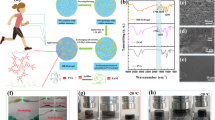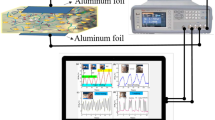Abstract
As a promising candidate for flexible epidermal strain sensor, the obvious resistance sensing signal drift of ionic conductive hydrogel affects its practical application significantly, and the AC impedance analysis appears to be an effective test method. Here, the rarely reported impedance sensing mechanism was investigated based on an axon-like ionic conductive hydrogel strain sensor, which is composed of cellulose hydrogel particles (CHPs) as the core sensing medium, rubber tube as the elastic cortex, and stainless steel as the electrode. Specifically, the prepared hydrogel strain sensor exhibited a negative ion concentration-dependent impedance sensing behavior, the impedance variation (△Z/Z0) and sensitivity (GF) at 400% reach 441.5 and 630.1, respectively. What is more, the AC impedance sensing behavior of the hydrogel sensor displayed good strain amplitude identifiability in a wide strain range up to 400%, ultralow detection limit (0.1% strain), excellent rate independence, and outstanding long-term fatigue resistance. Importantly, an equivalent circuit model was built, and the variation of ion transport impedance and electric double-layer capacitance at the electrode-CHPs interface during the tension process were verified to be the internal sensing mechanism. What is more, the special skin–core structure can effectively solve the dehydration problem and poor mechanical property of hydrogel, and the amounts of interfaces between adjacent CHPs are also beneficial for improving the impedance responsivity. We believe the proposed impedance response mechanism will undoubtedly provide important guidance for the design of high-performance ionic conductive hydrogel strain sensor.
Graphical abstract
An equivalent circuit model was proposed for explaining the impedance response mechanism of axon-like skin core–structured hydrogel strain sensor.






Similar content being viewed by others
References
Li S, Xiao X, Hu J, Dong M, Zhang Y, Xu R, Wang X, Islam J (2020) Recent advances of carbon-based elexible strain sensors in physiological signal monitoring. ACS Appl Electron Mater 2(8):2282–2300. https://doi.org/10.1021/acsaelm.0c00292
Wang D, Qin L, Yang W, He Y, Zhang S, Yang Y, Xu K, Gao P, Yu J, Cai K (2021) A conductive hydrogel based on galn and PVA/PAA/Fe3+ for strain sensor and physiological signal detection. Acs Appl Polym Mater 3(10):5268–5276. https://doi.org/10.1021/acsapm.1c01063
Pang Y, Yang Z, Han X, Jian J, Li Y, Wang X, Qiao Y, Yang Y, Ren T (2018) Multifunctional mechanical sensors for versatile physiological signal detection. ACS Appl Mater & Inter 10(50):44173–44182. https://doi.org/10.1021/acsami.8b16237
Bu Y, Shen T, Yang W, Yang S, Zhao Y, Liu H, Zheng Y, Liu C, Shen C (2021) Ultrasensitive strain sensor based on superhydrophobic microcracked conductive Ti3C2Tx MXene/paper for human-motion monitoring and E-skin. Sci Bull 66(18):1849–1857. https://doi.org/10.1016/j.scib.2021.04.041
Liu H, Chen X , Zheng Y, Zhang D, Zhao Y, Wang C , Pan C, Liu C, Shen C (2021) Lightweight, superelastic, and hydrophobic polyimide nanofiber/MXene composite aerogel for wearable piezoresistive sensor and Oil/Water separation applications. Adv Funct Mater 31(13). https://doi.org/10.1002/adfm.202008006
Chen J, Wang F, Zhu G, Wang C, Cui X, Xi M, Chang X, Zhu Y (2021) Breathable strain/temperature sensor based on fibrous networks of ionogels capable of monitoring human motion, respiration, and proximity. ACS Appl Mater & Inter 13(43):51567–51577. https://doi.org/10.1021/acsami.1c16733
Zhang J, Liu E, Hao S, Yang X, Li T, Lou C, Run M, Song H (2022) 3D Printable, ultra-stretchable, self-healable, and self-adhesive dual cross-linked nanocomposite ionogels as ultra-durable strain sensors for motion detection and wearable human-machine interface. Chem Eng J 431. https://doi.org/10.1016/j.cej.2021.133949
Hang C, Zhao X, Xi S, Shang Y, Yuan K, Yang F, Wang Q, Wang J, Zhang D, Lu H (2020) Highly stretchable and self-healing strain sensors for motion detection in wireless human-machine interface. Nano Energy 76. https://doi.org/10.1016/j.nanoen.2020.105064
Dong W, Yang L, Fortino G (2020) Stretchable human machine interface based on bmart glove embedded with PDMS-CB strain sensors. Ieee Sens J 20(14):8073–8081. https://doi.org/10.1109/jsen.2020.2982070
Chen J, Zhu Y, Chang X, Pan D, Song G, Guo Z, Naik N (2021) Recent progress in essential functions of soft electronic skin. Adv Funct Mater 31:2104686. https://doi.org/10.1002/adfm.202104686
Chang X, Chen L, Chen J, Zhu Y, Guo Z (2021) Advances in transparent and stretchable strain sensors. Adv Compos Hybrid Mater 4(3):435–450. https://doi.org/10.1007/s42114-021-00292-3
Zhang D, Xu S, Zhao X, Qian W, Bowen C, Yang Y (2020) Wireless monitoring of small strains in intelligent robots via a joule heating effect in stretchable graphene-polymer nanocomposites. Adv Funct Mater 30(13). https://doi.org/10.1002/adfm.201910809
Guo Q, Zhang X, Zhao F, Song Q, Su G, Tan Y, Tao Q, Zhou T, Yu Y, Zhou Z, Lu C (2020) Protein-inspired self-healable Ti3C2 MXenes/rubber-based supramolecular elastomer for intelligent sensing. ACS Nano 14(3):2788–2797. https://doi.org/10.1021/acsnano.9b09802
Tang L, Wu S, Qu J, Gong L, Tang J (2020) A review of conductive hydrogel used in flexible strain sensor. Materials 13(18). https://doi.org/10.3390/ma13183947
Zhang D, Ren B, Zhang Y, Xu L, Huang Q, He Y, Li X, Wu J, Yang J, Chen Q, Chang Y, Zheng J (2020) From design to applications of stimuli-responsive hydrogel strain sensors. J Mater Chem B 8(16):3171–3191. https://doi.org/10.1039/c9tb02692d
Sun X, Yao F, Li J (2020) Nanocomposite hydrogel-based strain and pressure sensors: a review. J Mater Chem A 8(36):18605–18623. https://doi.org/10.1039/d0ta06965e
You I, Mackanic D, Matsuhisa N, Kang J, Kwon J, Beker L, Mun J, Suh W, Kim T, Tok J, Bao Z, Jeong U (2020) Artificial multimodal receptors based on ion relaxation dynamics. Science 370(6519):961–965. https://doi.org/10.1126/science.aba5132
Jiang N, Hu D, Xu Y, Chen J, Chang X, Zhu Y, Li Y, Guo Z (2021) Ionic liquid enabled flexible transparent polydimethylsiloxane sensors for both strain and temperature sensing. Adv Compos Hybrid Mater 4(3):574–583. https://doi.org/10.1007/s42114-021-00262-9
Zhou H, Lai J, Jin X, Liu H, Li X, Chen W, Ma A, Zhou X (2021) Intrinsically adhesive, highly sensitive and temperature tolerant flexible sensors based on double network organohydrogels. Chem Eng J 413:127544. https://doi.org/10.1016/j.cej.2020.127544
Jiang N, Chang X, Hu D, Chen L, Wang Y, Chen J, Zhu Y (2021) Flexible, transparent, and antibacterial ionogels toward highly sensitive strain and temperature sensors. Chem Eng J 424:130418. https://doi.org/10.1016/j.cej.2021.130418
Huang J, Peng S, Gu J, Chen G, Gao J, Zhang J, Hou L, Yang X, Jiang X, Guan L (2020) Self-powered integrated system of a strain sensor and flexible all-solid-state supercapacitor by using a high performance ionic organohydrogel. Mater Horiz 7(8):2085–2096. https://doi.org/10.1039/d0mh00100g
Yang Y, Yang Y, Cao Y, Wang X, Chen Y, Liu H, Gao Y, Wang J, Liu C, Wang W, Yu J, Wu D (2021) Anti-freezing, resilient and tough hydrogels for sensitive and large-range strain and pressure sensors. Chem Eng J 403. https://doi.org/10.1016/j.cej.2020.126431
Xu J, Wang G, Wu Y, Ren X, Gao G (2019) Ultrastretchable wearable strain and pressure sensors based on adhesive, tough, and self-healing hydrogels for human motion monitoring. ACS Appl Mater & Inter 11(28):25613–25623. https://doi.org/10.1021/acsami.9b08369
Li Z, He X, Cheng J, Li H, Zhang Y, Shi X, Yu K, Yang H, Ge Q (2021) Hydrogel-elastomer-based stretchable strain sensor fabricated by a simple projection lithography method. Int J Smart Nano Mater 12(3):256–268. https://doi.org/10.1080/19475411.2021.1952335
Chen G, Huang J, Gu J, Peng S, Xiang X, Chen K, Yang X, Guan L, Jiang X, Hou L (2020) Highly tough supramolecular double network hydrogel electrolytes for an artificial flexible and low-temperature tolerant sensor. J Mater Chem A 8(14):6776–6784. https://doi.org/10.1039/d0ta00002g
Sun X, Qin Z, Ye L, Zhang H, Yu Q, Wu X, Li J, Yao F (2020) Carbon nanotubes reinforced hydrogel as flexible strain sensor with high stretchability and mechanically toughness. Chem Eng J 382. https://doi.org/10.1016/j.cej.2019.122832
Feng Y, Liu H, Zhu W, Guan L, Yang X, Zvyagin A, Zhao Y, Shen C, Yang B, Lin Q (2021) Muscle-inspired MXene conductive hydrogels with anisotropy and low-iemperature tolerance for wearable flexible sensors and arrays. Adv Funct Mater 31(46):2105264. https://doi.org/10.1002/adfm.202105264
Chen W, Liu L, Zhang H, Yu Z (2021) Kirigami-inspired highly stretchable, conductive, and hierarchical Ti3C2Tx MXene films for efficient electromagnetic interference shielding and pressure sensing. ACS Nano 15(4):7668–7681. https://doi.org/10.1021/acsnano.1c01277
Chen L, Wang Z, Zhan Z, Xie M, Duan G, Cheng P, Chen Y, Duan H (2021) 3D printed super-anti-freezing self-adhesive human-machine interface. Mater Today Phys 19:100404. https://doi.org/10.1016/j.mtphys.2021.100404
Shao L, Li Y, Ma Z, Bai Y, Wang J, Zeng P, Gong P, Shi F, Ji Z, Qiao Y, Xu R, Xu J, Zhang G, Wang C, Ma J (2020) Highly sensitive strain sensor based on a stretchable and conductive poly(vinyl alcohol)/phytic acid/NH2-POSS hydrogel with a 3D microporous structure. ACS Appl Mater & Inter 12(23):26496–26508. https://doi.org/10.1021/acsami.0c07717
Xu H, Shen Z, Gu G (2020) Performance characterization of ionic-hydrogel based strain sensors. Sci China Technol Sci 63(6):923–930. https://doi.org/10.1007/s11431-019-1511-4
Manandhar P, Calvert P, Buck J (2012) Elastomeric ionic hydrogel sensor for large strains. Ieee Sens J 12(6):2052–2061. https://doi.org/10.1109/jsen.2011.2181993
Kunzel M, Panhuis MI (2020) Strain sensors based on conducting poly(acrylamide) hydrogels. MRS Adv 5(17):917–925. https://doi.org/10.1557/adv.2020.112
Pan X, Wang Q, He P, Liu K, Ni Y, Chen L, Ouyang X, Huang L, Wang H, Xu S (2020) A bionic tactile plastic hydrogel-based electronic skin constructed by a nerve-like nanonetwork combining stretchable, compliant, and self-healing properties. Chem Eng J 379. https://doi.org/10.1016/j.cej.2019.122271
Funding
The research was financially supported by the National Natural Science Foundation of China (NO: 51803191, 12072325), the National Key R&D Program of China (2019YFA0706802), the 111 project (D18023), Key Scientific and Technological Project of Henan Province (202102210038).
Author information
Authors and Affiliations
Corresponding authors
Ethics declarations
Conflict of interest
The authors declare no competing interests.
Additional information
Publisher's Note
Springer Nature remains neutral with regard to jurisdictional claims in published maps and institutional affiliations.
Supplementary Information
Below is the link to the electronic supplementary material.
Supplementary file2 (MP4 15401 KB)
Supplementary file3 (MP4 26787 KB)
Rights and permissions
About this article
Cite this article
Zhang, D., Zhang, M., Wang, J. et al. Impedance response behavior and mechanism study of axon-like ionic conductive cellulose-based hydrogel strain sensor. Adv Compos Hybrid Mater 5, 1812–1820 (2022). https://doi.org/10.1007/s42114-022-00437-y
Received:
Revised:
Accepted:
Published:
Issue Date:
DOI: https://doi.org/10.1007/s42114-022-00437-y




